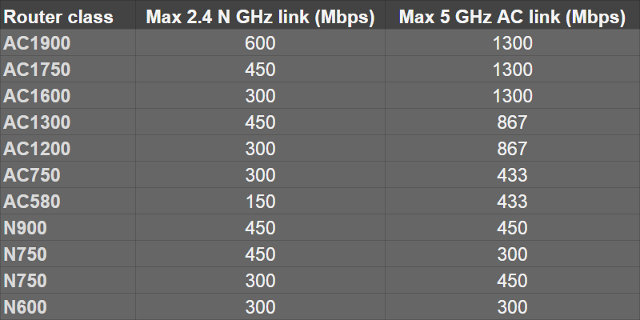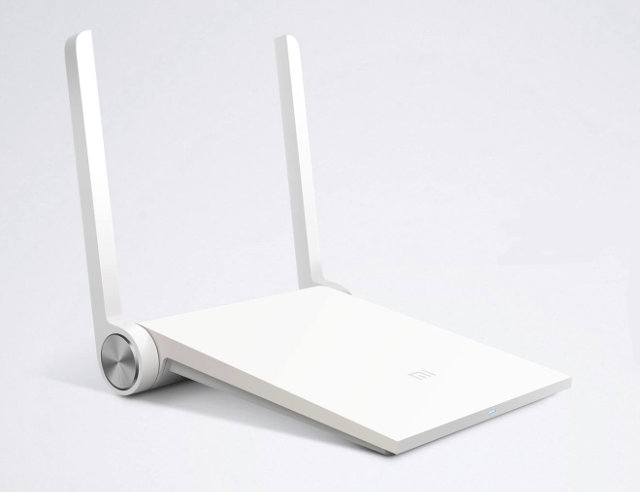Ever since TV boxes with 802.11ac capabilities have been listed, I’ve been looking at purchasing a router with the latest Wi-Fi standard since I would then be able to test 802.11n at 2.4 and 5 GHz, as well as 802.11ac. The vast range of prices got me confused at first, but an article on Connectedly helped me clear things out. One of the most important factor is the different classes of Wi-Fi routers as shown in the table below. The class nomeclature is based on the Wi-Fi standard (AC or N) with a number corresponding to the rounded sum of the maximum throughput at 2.4GHz and 5GHz.
 Based on this table, and my limited budget ($100), I decided to look for AC1200 or greater routers, and I found one for TP-LINK Archer C7 AC1750 router selling for $100 on Amazon. Awesome! So I went to look on local websites only to find out it sold for over $200 locally, and TP-Link Thailand confirmed that “of course!” prices were different in US and Thailand… But this morning, I discovered Xiaomi Mi Wi-Fi mini router sold for $45 on DealExtreme, and that it was an AC1200 router, and it’s even cheaper than some AC750 routers, so let’s check it out.
Based on this table, and my limited budget ($100), I decided to look for AC1200 or greater routers, and I found one for TP-LINK Archer C7 AC1750 router selling for $100 on Amazon. Awesome! So I went to look on local websites only to find out it sold for over $200 locally, and TP-Link Thailand confirmed that “of course!” prices were different in US and Thailand… But this morning, I discovered Xiaomi Mi Wi-Fi mini router sold for $45 on DealExtreme, and that it was an AC1200 router, and it’s even cheaper than some AC750 routers, so let’s check it out.
Xiaomi Mi Wi-Fi Mini router specifications:
- Wi-Fi SoC – Mediatek MT7620A @ 580MHz
- System Memory – 128 MB DDR2
- Storage – 16 MB SPI flash memory
- Wi-Fi
- Protocols – IEEE 802.11a/b/g/n/ac
- Transmission Rate – 300Mbps max @ 2.4GHz, 867 Mbps max @ 5GHz
- Wireless Security – WPA-PSK/WPA2-PSK encryption
- 2.4 GHz Channels: 1, 2, 3, 4, 5, 6, 7, 8, 9, 10 ,11, 12, 13;
- 5 GHz Channels: 149, 153, 157, 161, 165;
- 5 GHz DFS (dynamic frequancy selection) channels: 36, 40, 44, 48, 52, 56, 60, 64;
- Ethernet – 2x LAN (Fast Ethernet), 1x WAN (Fast Ethernet)
- USB – 1x USB 2.0 host port for external mass storage or 3GB dongle
- Power – 5V?
- Dimensions – 14.9 cm x 13.8 cm x 3 cm
- Weight – 253 grams
 The router is sold with a 100~240V power adapter, and a user’s manual in Chinese. The user interface will also be in Chinese, as well as the Android and iOS apps, which could be a problem. Having said that, Xiaomi mentions OpenWRT in their website, and some other devices based on MT7620 can run custom firmware, so there may be hope. But the biggest problem may be the 10/100M Ethernet ports used by the router, as they could possibly become the bottleneck while testing performance. So I’ll skip it for now myself. It’s also possible the price drops to around $35 as it’s sold for 129 CNY in China, or about $21. I could not find any decent reviews in English, but a review on Sina (in Chinese) appears to be more interesting, where they show a stronger signal than some other routers, but no actual throughput testing. You can find further details (in Chinese) on Xiaomi’s Mi Wi-Fi Mini page.
The router is sold with a 100~240V power adapter, and a user’s manual in Chinese. The user interface will also be in Chinese, as well as the Android and iOS apps, which could be a problem. Having said that, Xiaomi mentions OpenWRT in their website, and some other devices based on MT7620 can run custom firmware, so there may be hope. But the biggest problem may be the 10/100M Ethernet ports used by the router, as they could possibly become the bottleneck while testing performance. So I’ll skip it for now myself. It’s also possible the price drops to around $35 as it’s sold for 129 CNY in China, or about $21. I could not find any decent reviews in English, but a review on Sina (in Chinese) appears to be more interesting, where they show a stronger signal than some other routers, but no actual throughput testing. You can find further details (in Chinese) on Xiaomi’s Mi Wi-Fi Mini page.

Jean-Luc started CNX Software in 2010 as a part-time endeavor, before quitting his job as a software engineering manager, and starting to write daily news, and reviews full time later in 2011.
Support CNX Software! Donate via cryptocurrencies, become a Patron on Patreon, or purchase goods on Amazon or Aliexpress





